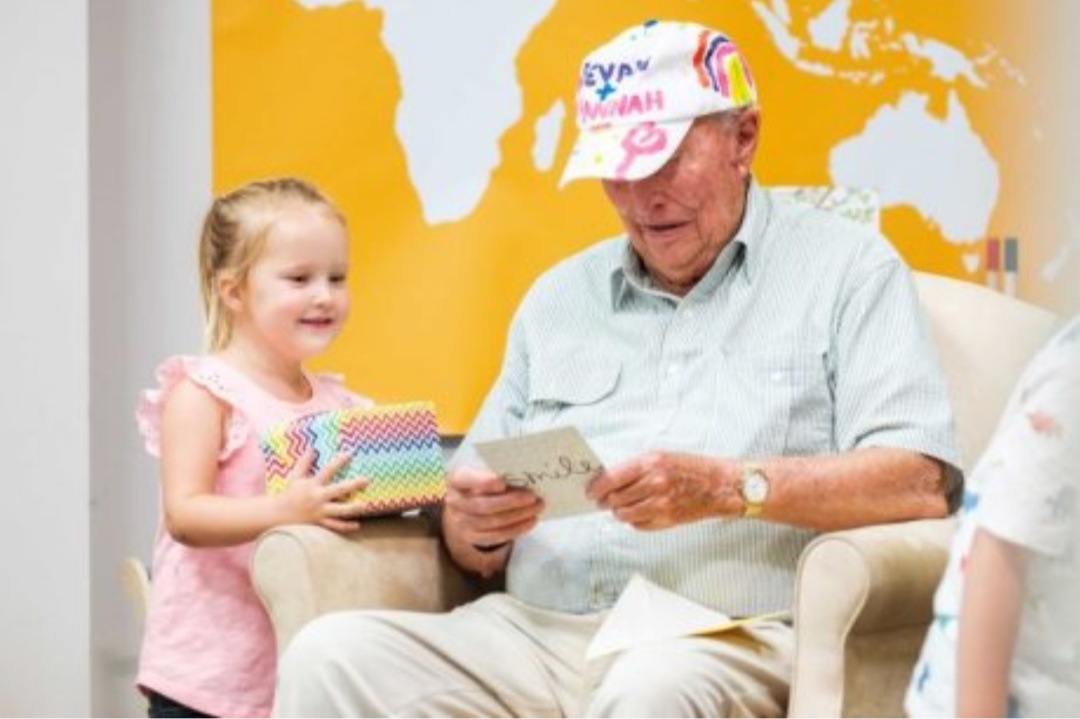The four Bs that help kids bond with their grandparents

Hannah was paired with Bevan on the ABC’s new documentary series Old People’s Home for 4 Year Olds.
Four-year-old Hannah has developed a new habit recently. She’ll walk right up to older people when she’s out in public and ask, “how are you today?”
Her mum Fiona Goode said Hannah had become more aware of older people since taking part in the ABC’s new documentary series Old People’s Home for 4 Year Olds.
Hannah’s grandparents live interstate and overseas, so she didn’t have many opportunities to interact with older people — that is, until she was paired with aged-care resident Bevan on the show.
“To see a 95-year-old man respect and admire the simple things like going for a walk and being able to read her a story like he loved to do with his children … it’s actually changed her,” Ms Goode said.
Ms Goode is an early childhood teacher and was asked to facilitate intergenerational activities between the older adults and children on the program.

PHOTO Fiona Goode was asked to facilitate intergenerational activities between the older adults and children on the show.
Older Australians provide a vital source of childcare for many Australian families. Apart from parental care, grandparents are one of the most common groups of carers for children up to 13 years of age who attend school.
However, for children who don’t attend school yet, day care is a more popular option.
Through her involvement in the show, Ms Goode has seen how rewarding intergenerational relationships can be between young children and older people, and how easy they can be developed.
“They just want human interaction, and really simplified tasks where they don’t have to be overly mobile,” she said.

PHOTO Intergenerational relationships are easy to develop and rewarding for everyone.
What can grandparents and kids bring to each other’s lives?
One of the key things grandparents can offer children is their undivided attention, compared to parents who may be doing a load of washing or watching TV while they’re looking after their kids.
When grandparents are with their grandchildren, Ms Goode said, “they stop everything they’re doing for that quality time”.
“It helps the children’s language development, it helps their sense of worth, it helps them feel like they belong,” she added.

PHOTO Grandparents are more likely to offer children their undivided attention, compared to busy parents.
In turn, children can also offer their grandparents time, attention and human connection.
“They’re bringing a spark and a joy,” Ms Goode said.
“A child picking a flower and getting an older person to smell it when they couldn’t bend down that far to pick it up, those simple interactions can bring a lot to both generations.”
How can I facilitate that relationship?
Ms Goode suggests parents bring along a bag of items when introducing children to their grandparents.
It could contain some of their favourite toys.
“Anything that you know as a parent your child is confident in talking about, or describing, or might be able to answer some questions if a person had a question about it,” Ms Goode said.

PHOTO Bringing along toys and items to play with can make introducing children and grandparents easier.
It could also hold some fun items to play with.
Ms Goode recommends the four Bs — “balls, balloons, boxes and bubbles”.
“They’re four things that I usually find are easy, accessible, and both generations can find something to do with,” she said.
Playdough is another option.
It appeals to kids and benefits older people by building strength in their hands.
Playing music and dancing can also break the ice between grandparents and kids because “you can be a bit silly”.
“An older person could show the child how they used to dance when they were younger, and obviously generations have changed as to what dance looks like these days,” Ms Goode said.

PHOTO Playing music and dancing can also help break the ice.
There are also ways to accommodate grandparents with mobility issues when dancing.
“They can stand holding their walker and have a bit of a boogie, or they can sit in their chair and tap their feet,” Ms Goode said.
Who benefits from intergenerational relationships?
Social isolation and loneliness are pervasive among older Australians.
In Australia, one in four people aged over 65 live alone, while one in five experience social isolation.
Loneliness is contributing to depression among elderly populations too.
Data from the Australian Bureau of Statistics shows that men over the age of 85 have the highest rate of suicide.
Triggers for loneliness can include the loss of a partner, friends and loved ones, or the decline of one’s physical and mental capacity. A higher proportion of older Australians also live in aged care homes.
The impact of this is well-documented: loneliness increases mortality and the uptake of behaviours like smoking and not exercising, and leads to poorer health outcomes such as high blood pressure.
However, human connection can be an antidote to loneliness for grandparents.
“Often they’re sitting in their rooms all alone, they’ve got a lack of mobility, so this is giving them a reason to get out of their room and to get some fresh air,” Ms Goode said.
“They’re going to have more interactions with people, they’re going to have more of a purpose and a reason for living.”

PHOTO Human connection can be an antidote to loneliness for grandparents.
Children gain a lot from interactions with older people too — especially empathy.
“When you’re putting the younger generation with the older generation, they have to learn to be a little bit careful, they have to learn that there are physical limitations,” Ms Goode said.
“It can be a bit of an eye opener for them to see people in wheelchairs or missing body parts and things like that… because it might not be their norm.”
Parents can also benefit from their children building relationships with their grandparents.
“I think we’re so busy and hurried a lot of the time that we don’t stop to think about the older generation,” Ms Goode said.

PHOTO Children can gain empathy from their interactions with older people.
“Life gets busy with sports and dance and day-to-day activities that you do tend to sometimes forget to touch base.
“I think the more we can work on it now as parents with children, we’re setting ourselves up with a better quality of life when we’re in the same predicament ourselves.
“It’s knowing that at some stage, this is going to be them — so how would you like to be spoken with and communicated with when you’re at that end?”

PHOTO Parents can also benefit from their children building relationships with their grandparents.
What makes intergenerational relationships hard?
It can be tricky to get kids and grandparents to start interacting and communicating.
Either, or both of them may feel awkward or shy.
“Don’t just quit after the first time,” Ms Goode said.

PHOTO Visiting grandparents as a group can ease the pressure and make it easier to break the ice.
Visiting grandparents as a group can ease the pressure and make it easier to break the ice.
“Take your next door neighbour, take someone from your mothers’ group so that you can go and have a bit of a more playful experience as opposed to that one-on-one chat,” Ms Good suggested.
“When you’ve got a group of people, there are a few more distractions and you can have a few more interactions.”
“Don’t just leave the child with the older person,” Ms Goode added. “Be a part of it.”
It’s also important to take into account the physical limitations of grandparents and plan activities to match their abilities.
A walk in the park can be challenging because of bumps on the path and the risk of a fall.
If you want to go outdoors, do a bit of research and find accessible places to go.
“If you’ve got an open, uninterrupted space, it’s quite an easy walk,” Ms Goode said.

PHOTO It’s important to take into account the physical limitations of grandparents.
“They can smell things, they can feel things, they can feel the livelihood and the fresh air.”
And it’s okay to keep it simple.
“They don’t want much,” Ms Goode said.
“They just want someone to sit beside them and have a chat.”
Even if a child’s grandparents don’t live nearby, Ms Goode said they would be happy with just a phone call.



